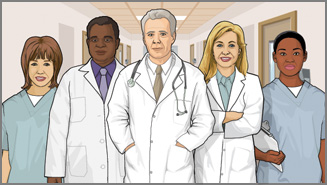Health exams for: #AGEGROUP#
The following exams, tests, and procedures are recommended for #AGEGROUPLOWER#.#FEMALETEXT#
Select a link from the list below to learn how and why each test is performed, as well how to prepare for it.

The following exams, tests, and procedures are recommended for #AGEGROUPLOWER#.#FEMALETEXT#
Select a link from the list below to learn how and why each test is performed, as well how to prepare for it.
When blood flow to an area of your brain stops, it's serious. It's called a stroke, and will often cause permanent, debilitating damage to your brain and change your life. Let's talk about strokes. If blood flow to your brain is stopped for longer than a few seconds, your brain can't get blood and oxygen. Brain cells die, causing permanent damage. There are two types, ischemic stroke and hemorrhagic stroke. Ischemic stroke happens when a blood clot forms in a very small artery, or when a blood clot breaks off from another artery and lodges in your brain. Hemorrhagic strokes can happen when a blood vessel in your brain becomes weak and bursts open. High blood pressure is the number one risk factor for strokes. People with atrial fibrillation, when your heart rhythm is fast and irregular, diabetes, a family history of stroke, and high cholesterol are most at risk. You are also at risk for stroke if you are older than age 55. Other risk factors include being overweight, drinking too much alcohol, eating too much salt, and smoking. Symptoms of a stroke usually develop suddenly, without warning. You may have a severe headache that starts suddenly, especially when you are lying flat, often when you awake from sleep. Your alertness may suddenly change. You may notice changes in your hearing, your sense of taste, and your sense of touch. You may feel clumsy or confused or have trouble swallowing or writing. So, how are strokes treated? A stroke is a medical emergency. Immediate treatment might save your life and reduce disability. Call your local emergency number -- or have someone call for you -- at the first sign of a stroke. Most of the time, someone having a stroke should be in the hospital within three hours after symptoms first begin. If a doctor suspects you've had a stroke, the doctor will check for problems with your vision, movement, feeling, reflexes, and your ability to understand and speak. You may have several tests to check for blocked or narrowed arteries. If the stroke is caused by a blood clot, you'll be given a clot-busting drug to dissolve the clot. Treatment depends on how bad your stroke is and what caused it. But you will probably need to stay in the hospital for a few days. Besides clot-busting drugs, called thrombolytics, you may need blood thinners, medicine to control high blood pressure, and surgery to unclog one of your carotid arteries-which carry blood to the brain. After your stroke, treatment will focus on helping you recover as much function as possible, and preventing future strokes. Most people need stroke rehabilitation therapy. If you can return home, you may need help making safety changes in your home and to help you with using the bathroom, cooking, dressing, and moving around your home. After a stroke, some people have trouble speaking or communicating with others, and a speech therapist might help. Depending on the severity of the stroke, you may have trouble with thinking and memory, problems with your muscles, joints, and nerves, trouble going to the bathroom, and difficulty swallowing and eating. Therapies and support for you and your family are available to help with each of these problems. Your treatment will also focus on preventing another stroke. You may need to be on several medications to help prevent this. And, eating healthy and controlling problems like diabetes and high blood pressure can be very important.
Review Date: 2/11/2025
Reviewed By: Joseph V. Campellone, MD, Department of Neurology, Cooper Medical School at Rowan University, Camden, NJ. Review provided by VeriMed Healthcare Network. Also reviewed by David C. Dugdale, MD, Medical Director, Brenda Conaway, Editorial Director, and the A.D.A.M. Editorial team.


